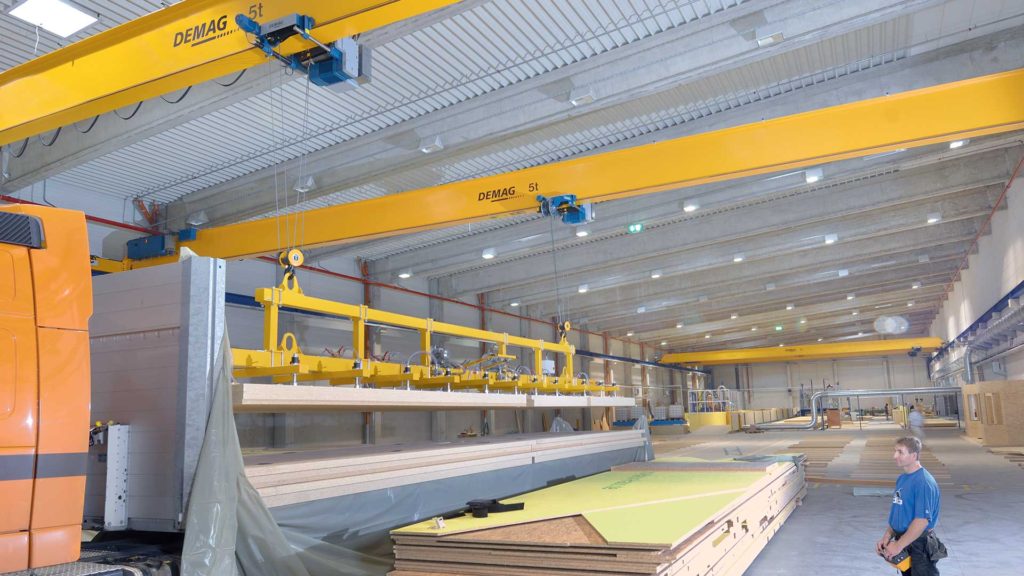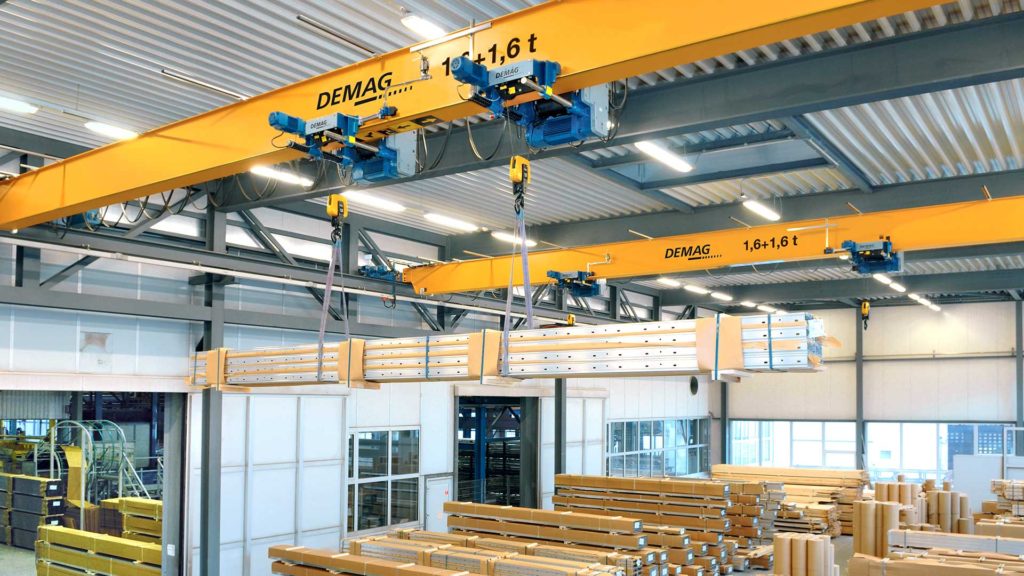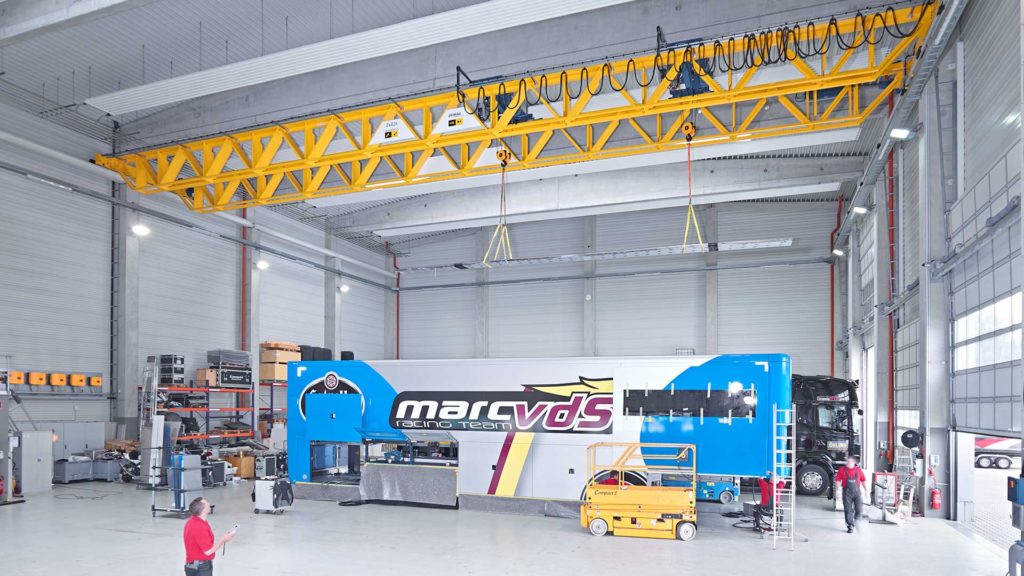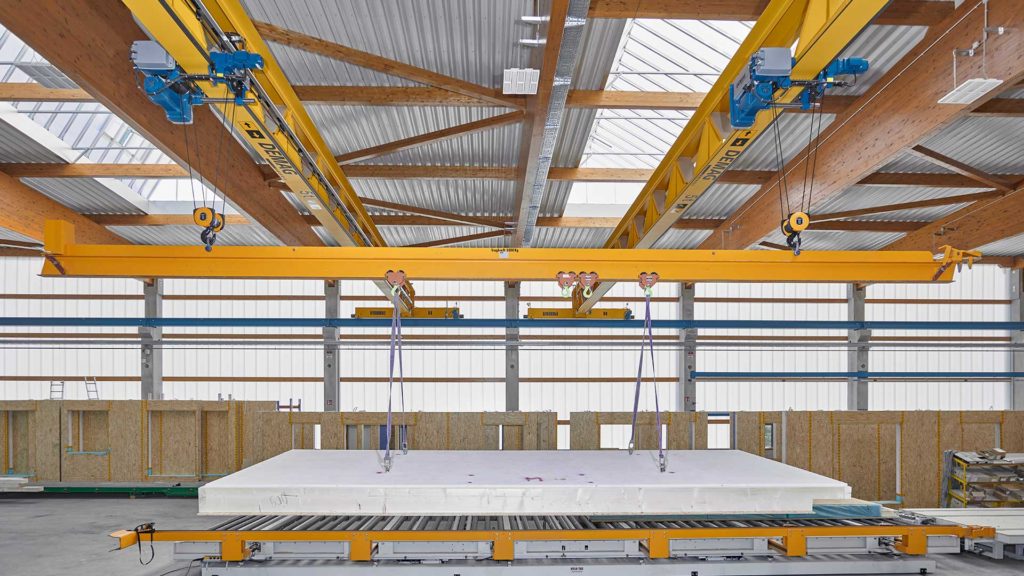Lifting long, large, awkward product with an overhead crane and hoist has special requirements for the safety and efficiency of your operations. One solution may be lifting these products with two hoists, or tandem hoists. Read more about dual hoist lifting solutions.
Heavy, long products can be effectively lifted with two wire rope hoists, or tandem hoists. This means that two wire rope hoists are synchronized to lift and travel at the same speed. Lifting a long product with two hoists can minimize product damage and prevent drops. Synchronizing two hoists allows for efficient travel for lifting, moving, and lowering this type of awkward load.

In the wood products industry, moving large, awkward loads is standard procedure. Manufacturers of prebuilt walls and large housing and building panels need a solution to lift and move these components during production, placement of products in storage areas, and loading products onto trucks for shipping.

Metal warehousing and fabrication industries can handle a wide variety of large, awkwardly shaped loads. From long pieces of metal bar to finished goods, a critical part of your production process is being able to move products efficiently and safely through your production facility. Similarly for the precast and prestressed concrete industries, effectively and safely moving awkward product through your production process is key to minimize damage to finished goods and efficient operations.
The First Step- Define Your Lifting Process
No matter what type of product you need to lift, you need to look at your process and operational requirements. Know your process, including any need to flip or turn loads. Look at the shapes and kinds of products you’ll be handling, lifting, and setting. Know the dimensions and weights of all the products you need to move with the lifting equipment. Determine the furthest point or points where you will need to set your heaviest products and loads. Working with a knowledgeable crane manufacturer or dealer will assure your project is a success.
Wire Rope Hoists to Meet Your Requirements
Understanding your lifting processes is focused on the wire rope hoist. Not only should you know the more general details like capacity, lift height, and processes in the area where lifting will happen, but other details critical to your operations. You should understand how precise your lifting needs to be. For instance, the product being lifted is fragile, positioning to remove a product mold, or when setting a product must be very precise. Some operations require a load hold brake to act as an additional emergency brake or allow the load to be held in place. In addition, if the lifting environment is aggressive or extreme, this can determine the hoists to meet your requirements.
Lifting with Tandem Wire Rope Hoists
Lifting long, awkward shaped loads overhead may require the use of two wire rope hoists and trolleys. Using two hoists and trolleys makes lifting safer for long, awkwardly shaped products. Dual hoist lifting can be designed with two hoists running on one crane girder, allowing for full load lifting on one overhead crane. Alternatively, two hoists can be synchronized on two overhead cranes for dual hoist lifting.

When two hoists can lift on one crane girder, this allows your operations to lift with one hoist or both. This can add flexibility for your operations. The hoists can be used independently for different lifting processes, meeting the capacity requirements of the crane and hoist. Then both hosts can be synchronized to lift a load when required. If this is the lifting solutions for your operations, make sure you also know the single hoist loads you will be lifting so the crane can be engineered to meet your needs.

Synchronizing hoists on two different crane girders allows for dual hoist lifting. This allows operators to use two overhead cranes and hoists independently and together for lifting processes. The wire rope hoists can be synchronized through programming on the radio control for lifting, moving, and lowering large and awkward loads for tandem lifting. This solution for tandem lifting requires you to understand your lifting processes for two cranes independently and for use in tandem.
Solutions to Meet Your Needs
Demag wire rope hoists can meet your standard and non-standard lifting needs. The DVR rope hoist is a flexible solution for standard lifting of loads up to 80 tons. It’s available in configurations for use on single girder cranes, double girder cranes, and monorail cranes.
If you have additional requirements for a wire rope hoist, the DH wire rope hoist meets the needs of non-standard lifting. Designed for long hook paths and capacities up to 100 Tons, the DH hoist meets your needs in extreme environments with high levels of moisture, heat, or dust. When equipped with mechanical co-axial F10 motors, the DH can deliver the precise positioning needed in your operations.

Synchronizing Wire Rope Hoists
Synchronous control with a radio allows these hoists to lift, travel, and lower at the same speed. This can be accomplished a few ways. The Demag DVR rope hoist has smart controls, easily allowing tandem, synchronized lifting for awkward loads.
When contactor controlled wire rope hoists are used for synchronized lifting, both hoists need to be identical. Commonly, these wire rope hoists are VFC, or variable frequency control, hoists, but it can also be accomplished on 2-speed hoists. The two identical hoists can be programmed for synchronized lifting through the radio control.
Lifting awkward, large, or long loads requires a unique solution to meet your needs. Understanding your lifting process needs is the first step to finding a solution. Whether you are lifting these loads with two hoists on one crane girder or two hoists and two cranes, dual hoist lifting can make your operations safer and more efficient. Remember, partnering with an experience crane manufacturer and dealer will make sure your solution will meet your operational needs.
